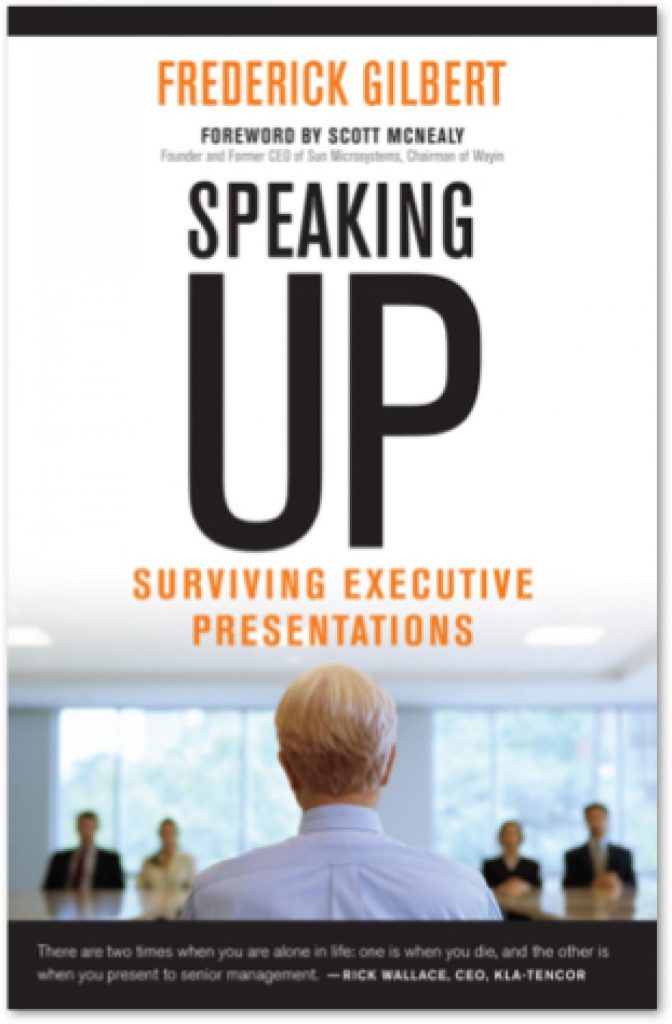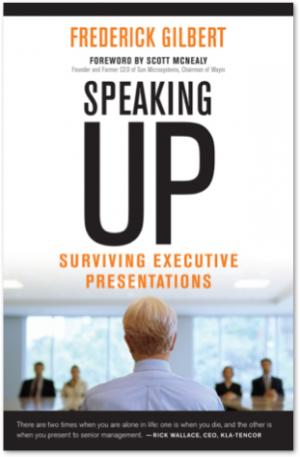Speaking Up: Surviving Executive Presentations
by Rick Gilbert
You are a smart, high-potential middle manager rocketing up the corporate ladder. Your team is working on a project that could catapult your company ahead of the competition. All that remains is to convince senior leadership to give you the funding to make it happen.
You walk into the C-level presentation room with your 30 PowerPoint slides. Almost immediately, a full-blown executive food fight starts. You look to your sponsor for help, but she isn’t paying attention. The executives drift off agenda as you fumble with your slides. You wonder, “What the hell just happened,” as you are politely dismissed from the room. Leaving the building, your dream of corporate stardom fades quickly.
If you are in middle management, you live with daily ambiguity, lack of control, and even chaos. To get anything done, you must present your ideas to people up the chain, and those presentations can be brutal. Careers and projects can come unwound in a matter of minutes if a presenter at the top level doesn’t know the rules.
Like an anthropologist in some mysterious far-away land, for the past ten years I’ve been working to discover the secret rules that govern the C-suite. Doing interviews with over 50 C-level executives, I’ve pieced together this puzzle. What we’ve learned in this research could save your career, your project, and even your company. So, what are the rules?
The good news: the rules are simple and easy to learn:
You have 30 seconds to get to the point;
You must present with confident (not slick) style, lately called “executive presence;”
Present like a jazz musician: improvise;
Dump the slides and have a discussion.
Unfortunately a staggeringly high number of mid-level people (67%, actually) march right into top-level meetings and shoot themselves in the foot by:
Not saying what they want at the beginning;
Being too aggressive or too passive in their delivery;
Rigidly sticking to their scripts;
Having too many PowerPoint slides.
The cost of a 67% failure rate is staggering. If you are presenting to the top five people in a mid-sized company ($6 – $8 billion in revenue), the executives around that table are costing the share holders about $30,000 / hour. Do the math. Two or three meetings a week at a failure rate of roughly $20,000 / meeting, can cost hundreds of thousands, even millions, of dollars / year in lost productivity. These stats come from the executives we’ve interviewed.
As you walk to the front of the room and take your place at the head of the oval mahogany table, you better know the dynamics and history of that C-level group. It is not your meeting. You are a guest at their meeting. They can treat you with respect, or callous disregard. In surveying middle managers, we’ve learned there are “Seven Deadly Challenges” you need to be prepared for:
They cut your time
They get distracted with their devices
They have an executive food fight
They change the topic without warning
The key decision maker walks out
They engage in side-talk
They have a fast-moving energetic discussion
Know the culture. Check it out with your sponsor. Talk to others who’ve presented to this team. Keep in mind the reality of the stressful world top-level people live in. They are very bright, time pressured executives with little job security. Their average job tenure is 23 months. They are under huge financial performance pressures. At the end of the first year on the job, if the stock price goes down, there is a 73 percent chance the new CEO will be fired, according to a report in the Harvard Business Review. However you are treated in the brief moments of that critically important presentation, whether with appreciation for your contribution, or with disrespect, it is not about YOU. They have bigger issues to deal with.
As one HR executive put it:
I’m a tool of management. My job is to give senior executives information, lay out a set of options, or maybe ask for a decision . . and then leave. I’m not there to be their buddy or to get pats on the back. A presentation isn’t a personal development opportunity or a chance for increased visibility. I’m there to do a job. And that job is to help prepare the executives to make the best possible decisions for the company.
Seeing your presentation in the cold hard light of day will help you be successful. It is not about a promotion. It is not about being friends with the executives. It is about helping them be more effective.
If you follow these tips, the chances of getting what you want and being someone they trust go way up. You will be seen as having “executive presence.” Since you will get the funding, you will become a hero to your team. Your career prospects will brighten. Good luck.
For more information:
Chinese Version




